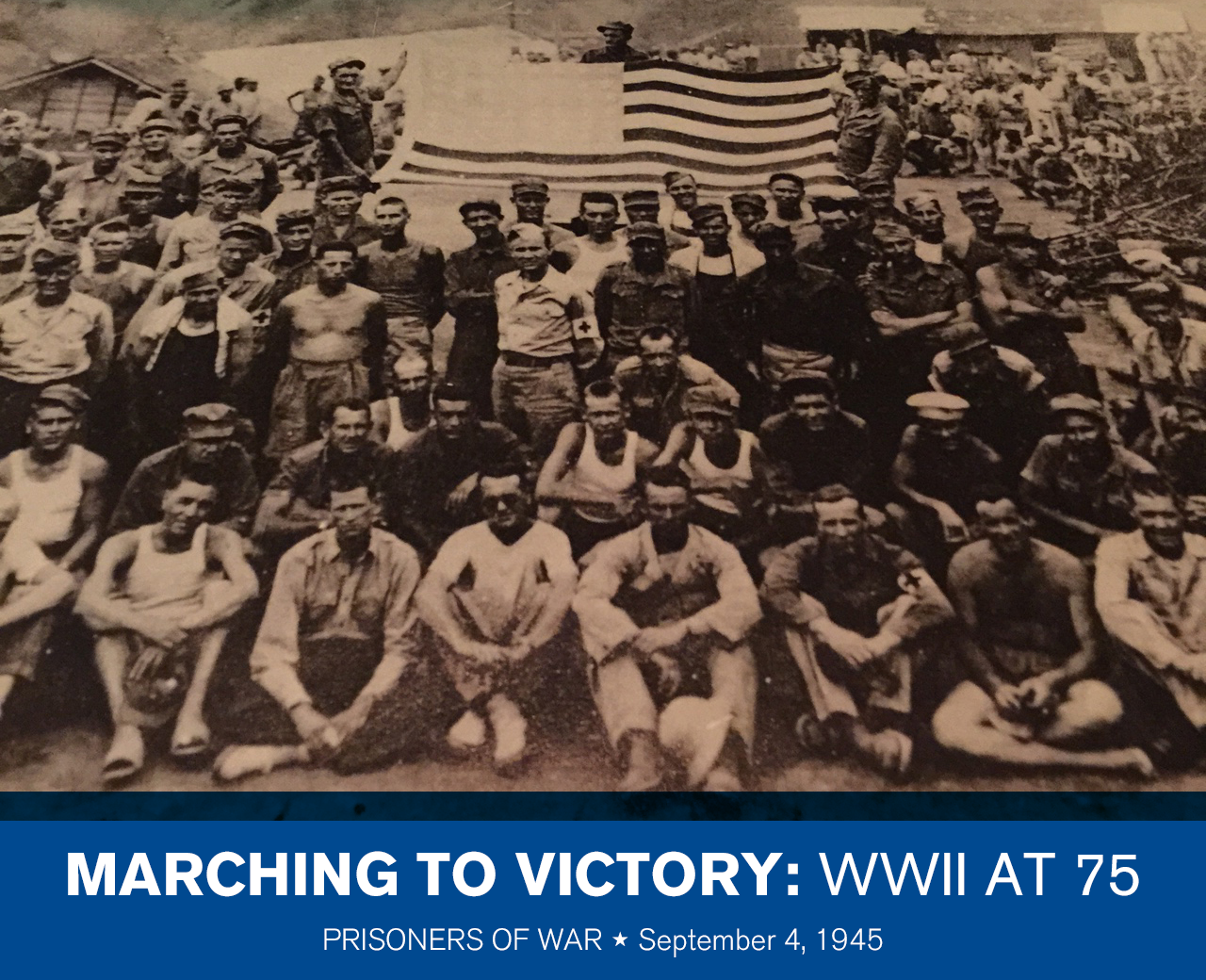WWII 75: Marching to Victory | September 4, 2020

WWII highlights from the Truman Library’s archives and collections
Marching to Victory: Prisoners of War
September 4, 1945
To Private Luther D. Bass and the hundreds of other Allied survivors of Tokyo POW Camp #8B, time must have seemed like it slowed to a crawl in early September 1945. Bass and many of his fellow prisoners of war had been captives of the Japanese for over three years, suffering hunger and forced labor. Now the war was over and they had been evacuated to the town of Onahoma to await liberation. Yet it would take several days for American forces to reach Onahoma. How had Bass survived his captivity, and how would he and his fellow POWs endure their anxious wait for liberation?
For the millions of occupied peoples and thousands of Allied soldiers captured by the Japanese during the war, conditions were often horrific.
While no nation, Allied or Axis, ended the war with a spotless record, Japanese troops gained notoriety for their cruelty toward prisoners. Early in the war, Japan had pledged to follow the protocols of the 1929 Geneva Convention—which forbade mistreatment of POWs—but Japanese leaders violated this agreement, encouraging their soldiers to brutalize enemy captives.
Japanese troops used some POWs for bayonet practice, tortured and starved others, and forced many to perform hard labor. Nearly one third of American POWs held by the Japanese died in captivity.
Private Luther D. Bass, a native of Georgia, was captured with thousands of other Americans when the Philippines fell to the Japanese in the spring of 1942. Unlike many of his fellow POWs, Bass survived two years of imprisonment in the Philippines. In March 1944, the Japanese loaded him and about 300 other men aboard a ship bound for Japan. Japanese POW transport vessels were called “hell ships” for their terrible conditions and frequently attacked by Allied ships and aircraft, but the 300 prisoners landed safely in Osaka. (The following month, the ship they had traveled on was sunk by an American submarine.) From Osaka, Bass and his fellow POWs were sent to a mining camp called Hitachi or Tokyo #8B.
The new inmates of Tokyo #8B became slave laborers in copper mines along with captive Koreans.
Conditions were certainly poor, but they could have been worse. “I remember no incidents of brutality,” American POW Martin S. Christie later wrote. “Occasionally someone got slapped around but nothing of a serious nature. The Japanese Camp Commander was a graduate of Northeastern University and the interpreter was a mixture of Japanese-Caucasian ancestry. Working conditions in the mines were rough, but the [Japanese] civilian workers were in the most part kind to us.” Bass, Christie, and their fellow prisoners lived and worked in the camp for the next 16 months.
Relief for Allied prisoners of the Japanese finally appeared on the horizon in August 1945 when Emperor Hirohito agreed to surrender. Recent days had been tense—especially since some Japanese officials apparently argued for the execution of all prisoners should the Allies invade. Fortunately, Japan’s surrender saved the country from invasion and possibly many prisoners’ lives.
On August 26, Luther Bass and the inmates of Tokyo #8B received a welcome present from an U. S. Army B-29 bomber: an airdrop of badly needed food and clothing. Bass — whose American pride had survived more than three years of captivity — cut and sewed parachutes from the supply drop into an American flag.
With their guards gone, the former POWs left for Onahoma on September 2 to await rescue by a U. S. Navy ship.
However, in what must have been a maddening delay, a failure in communication kept the POWs in Onahoma for another week. Fortunately, relations with the Japanese residents of the town were friendly. The former POWs finally received new instructions from the high command directing them to Tokyo.
While his homeward odyssey took several more weeks, Luther Bass eventually returned to Georgia. The flag that he had stitched together out of parachutes and patriotism also survived, and in 1973 fellow Tokyo #8B prisoner Earl R. Short donated it to the Harry S. Truman Library and Museum.

Source: Martin S. Christie, “A Short History of Tokyo Branch Camp #12 Motoyama (Hitachi),” http://www.mansell.com/pow_resources/camplists/tokyo/tok-08b-motoyama/tok-08b_motoyama_history.htm.
More to Explore
- Relive history in The White House Decision Center. Step back to 1945 and into the roles of President Truman, J. Robert Oppenheimer and other West Wing advisors. How will WWII end? You decide.
Marching to Victory
75 years ago, World War II ended under President Truman’s decisive leadership. Now, follow key events from the war’s final months with the Truman Library Institute’s series, “Marching to Victory: WWII Highlights from the Truman Library’s Archives and Collections.” The 25-part blog series opens the vaults at Truman’s presidential library to share eyewitness accounts and historic artifacts related to major conflicts and monumental victories – from the Battle of the Bulge to the liberation of Dachau to the unconditional surrender of Japan.
More in this series:
Marching to Victory: Iwo Jima
Marching to Victory: The Bombing of Dresden
Marching to Victory: The Yalta Conference
Marching to Victory: The Battle of the Bulge
Marching to Victory: The Tokyo Fire Raids
Marching to Victory: The Battle of Okinawa
Marching to Victory: The Liberation of Buchenwald
Marching to Victory: “The President is Dead”
Marching to Victory: The Liberation of Dachau
Marching to Victory: The Death of Adolf Hitler
Marching to Victory: Germany Surrenders!
Marching to Victory: Victory Gardens
Marching to Victory: Civil Rights
Marching to Victory: The United Nations
Marching to Victory: How Children Helped Win the War
Marching to Victory: The First Atomic Bomb Test
Marching to Victory: The Potsdam Conference
Marching to Victory: The Potsdam Declaration
Marching to Victory: The Bombing of Hiroshima
Marching to Victory: The Bombing of Nagasaki
Marching to Victory: The Surrender of Japan
Marching to Victory: The Formal Surrender of Japan
Join our email list to receive Truman updates right in your inbox:


